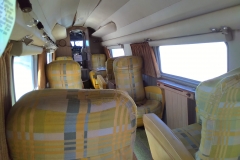




Did you have to shoot buffalo for food? Did you have to float across the river? Did people die of dysentery? Okay, so it was nothing like the Oregon Trail computer game (remember having to write your own epitaph?), but it was still interesting.
In 1947 there wasn’t yet a fully mature interstate system, fewer gas stations, no 24-hour Wal-Marts, no cell phones, and cars were less dependable and required more maintenance. “Orconn” from CadillacOwners.com recalls his childhood, detailing a trip he took from New Jersey to Pasadena in his father’s 1940 Packard 120.
I asked him, “What was cross-country travel like in those cars? Were there more concerns over breakdowns in the middle of nowhere?” The details most noteworthy to those of us younger than 35 are in bold, but you’ll want to read the whole thing to get a feel for the time.
The entire discussion can be viewed here.
This was his wonderfully thorough response:
I don’t remember any break downs along the way, but I do remember carrying canvas water bags on the front fenders to have somewhat cool water to replenish the radiator going through mountains and the western desert. I also remember at times it was hot as hell and that we always had the windows open wide to catch the wind. Remember most of the way the speed limit was 45 mph and there were speed traps (15 and 25 mph speed limits) almost at every small town you passed through.
The roads by and large were two or occasionally four lanes either undivided or with cement dividers the size of today’s parking lot tire stops. The only limited access highway was the Pennsylvania Turnpike and you didn’t follow it to its’ end but turned off at Washington, PA to go by two lane highway to Wheeling, West Virginia where you picked Interstate 40 which alternated between two, four and three (one each way with the middle lane for passing in either direction) lanes onward to Chicago. There you picked up Route 66 for the rest of your trip to California. Route 66 was a non limited access highway made up of segments of different numbers of lanes with local traffic entering and leaving the roadway from businesses and side roads. Traffic involving slow moving cars and trucks was the norm and it was only when you got past Missouri that things really opened up and higher speeds could be maintained.
Of course seat belts weren’t even thought of for passenger cars at that time. My favorite place to ride was to stand in the wide space between the back seat and the back of the front seat, about where the ashtray was located with my hands on the front seat back, so I could see between my parent’s shoulders and out the windshield. My Dad and I had a game we played almost all day in which each of us would name the year, make and model of the cars coming toward us. Both of us were pretty good at it so it was a fun game to pass the time as we churned away across the United States.
One of the big differences between these kinds of roads and the interstates of today was all the interesting sights to be seen along the way as terrain and road side attractions changed with the different regions of the country that you passed through. Route 66 was also a local highway and didn’t bypass any of the towns and cities along its way. So you slowly made your way through city traffic in the bigger cities and were kept moving slowly through each little town you came to as the local citizens went about their business.
Then there were the mom and pop motels and the small town hotels you had use for accommodation when you stopped for the night. There was no air conditioning, and you were lucky if you stopped at a place that was clean and fairly quiet from the highway traffic.
I remember the trip as a great adventure, but then that is my nature, I think my sister hated the ride and hated moving to new places. People did make the trip across country. My mother’s parents came out California several times in there 1938 Chrysler New Yorker and in the 1950’s all 11 of my mother’s sisters and brothers made the trip from the Mid-West. And of course there were the great migrations to new work locations during the Second World War.
I am glad I still have the memories of traveling the U.S. at that time and regret my son never experienced the country in the way those old roads made possible. Today you can easily make it by interstate from L.A. to N.Y.C. in three and a half days, but the isolation of the interstates means you will miss all the color and excitement of seeing the various parts of the country up close and personal. The same goes for air travel, but that’s another story!
The discussion covers all kinds of cars from before World War II, especially luxury brands.
[…] A Good Friend. One of my favorite orconn stories, about what road trips were like in the 1940s:http://jesda.com/2011/02/05/what-wer…-in-the-1940s/ Share Share this post […]